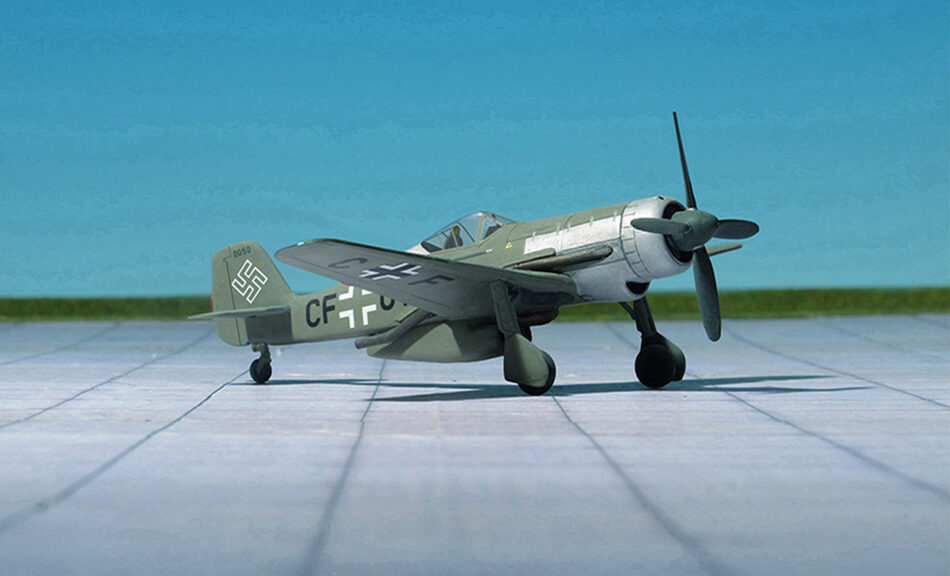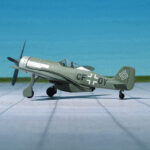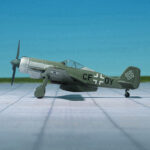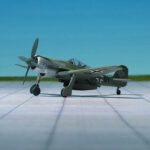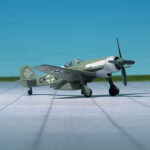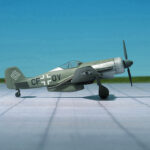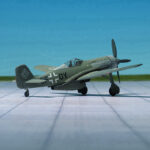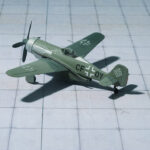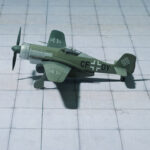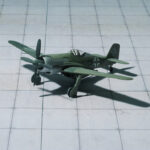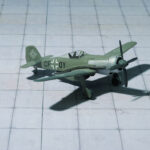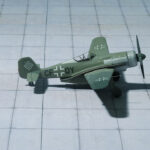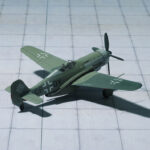TYPE: High-altitude interceptor
ACCOMMODATION: Pilot only
POWER PLANT: One Daimler-Benz DB 605G liquid-cooled engine plus one Hirth 9-2281 turbocharger, rated at 1,775 hp
PERFORMANCE: 426 mph at 38.714 ft
COMMENT: Even before the Focke-Wulf Fw 190A was put into service, its high-altitude performance was seen to be deficient. In contrast, the Daimler-Benz DB 601 liquid-cooled engines used on the Messerschmitt Me 109 featured an advanced fluid-coupled, single stage, variable speed supercharger that provided excellent boost across a wide range of altitudes. The Fw 190’s short wings also presented a problem at higher altitudes, where they were highly loaded. As a result, the Fw 190 could not compete with the Me 109 at altitudes above 20,000 ft, which is one reason that the Me 109 remained in production until the end of the war. This was not a serious concern at the time of introduction, as most combat was taking place at medium altitudes, where the Fw 190 had ample performance.
However, as the air war reached higher altitudes with the widespread introduction of turbocharged US bombers, the need for improved performance became pressing. As a result, GM-1 nitrous oxide boost was introduced to provide more power at altitude, but this was complex and gave boosted performance for only a short period of time.
Tank started looking at ways to address the altitude performance problem early in the program. In 1941, he proposed a number of Fw 190 versions featuring new power plants, and he suggested using turbochargers in place of superchargers. Three such installations were outlined: the Fw 190B with a turbocharged BMW 801, the Fw 190C with a turbocharged Daimler-Benz DB 603, and the Fw 190D with a supercharged Junkers Jumo 213. The aircraft would also include a pressurized cockpit and other features making them more suitable for high-altitude work. Prototypes for all three models were ordered.
The Focke-Wulf Fw 190 V12 (an A-0) would be outfitted with many of the elements which eventually led to the Fw 190B series. As it was based on the same BMW 801 engine as the A models, airframe modifications were relatively minor. These included a pressurized cockpit which doubled the panes of glass in the canopy so that hot air could be forced between them to prevent icing, and the addition of the GM-1 nitrous oxide injection system. Several problems were encountered during the machine’s flight and ground trials, mostly caused by the pressurization system for the cockpit, and for this reason the first Fw 190B-series testbed airframe was retired from active service in late 1942.
The Focke-Wulf Fw 190C model’s use of the longer DB 603 engine required more extensive changes to the airframe. As the weight was distributed further forward, the tail of the aircraft had to be lengthened in order to maintain the desired center of gravity. To test these changes, several examples of otherwise standard 190A’s were re-engined with a supercharged DB 603 to experiment with this engine fit, with the 1,726 hp DB 603A, the similar V15 and V16, a 1,775 hp DB 603 E being fitted to the latter after a time. With this engine, the V16 was able to reach 450 mph at 22,310 ft, a considerable improvement over the 400 mph at 17,060 ft of the basic Fw 190A models.
Fw 190 V18 followed, the first to feature the full high-altitude suite of features, including the pressurized cockpit, longer wings, a Daimler-Benz DB 603G engine driving a new four-blade propeller, and a Hirth 9-2281 turbocharger. Unlike the experimental Fw 190B models, V18 had a cleaner turbocharger installation, running the required piping along the wing root, partially buried in the fillet, and installing both the turbocharger air intake and intercooler in a substantially sized teardrop shaped fairing under the cockpit. This “pouch” led to the “Känguruh” (Kangaroo) nickname for these models. V18 was later modified to the Fw 190 V18/U1, with a “downgraded” DB 603A engine, but a new DVL turbocharger that improved power to 1,580 hp at an altitude of 35,105 ft. Four additional prototypes based on the V18/U1 followed: V29, V30, V32 and V33 (Ref.: 24).
